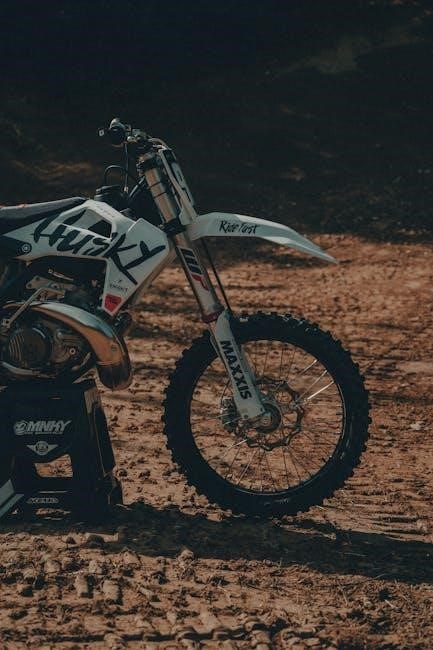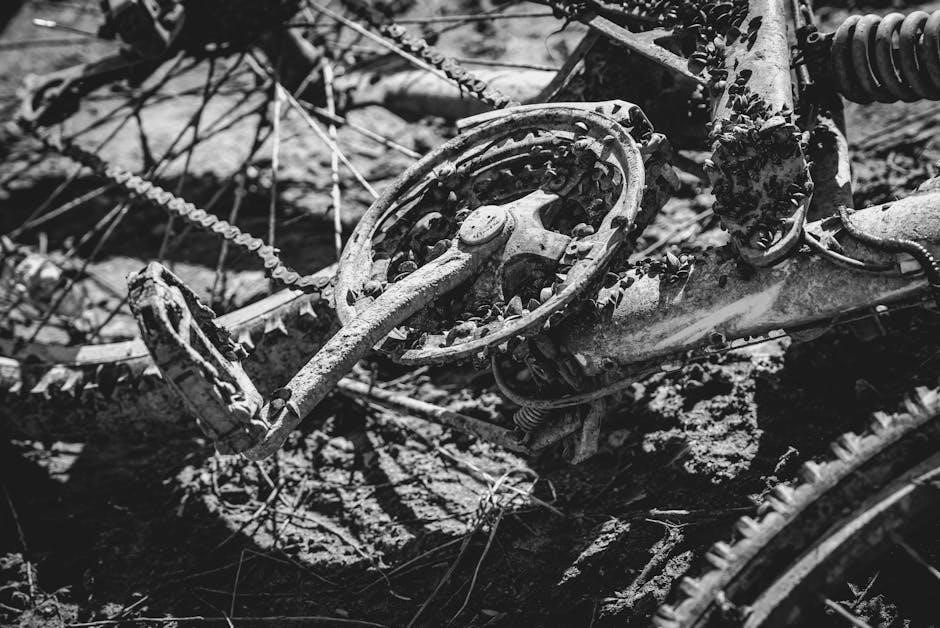
ground assault front bike suspension owners manual pdf
The Ground Assault Front Bike Suspension is a high-performance system designed for durability and precision, ensuring a smooth ride on various terrains. This manual provides essential guidance for setup, maintenance, and troubleshooting to optimize your biking experience.
1.1 Overview of the Ground Assault Bike Suspension System
The Ground Assault Front Bike Suspension System is a robust and responsive component designed to enhance ride quality and control. It features adjustable settings for rebound and compression, allowing riders to tailor performance to their weight and terrain. The system ensures optimal absorption of impacts, maintaining tire contact with the ground for improved traction and stability. Regular maintenance, such as oil changes and seal inspections, is crucial to sustain its effectiveness. This system is engineered to withstand rigorous off-road conditions while delivering a smooth and precise riding experience for mountain bikers.
1.2 Importance of Proper Suspension Maintenance
Proper maintenance of the Ground Assault Front Bike Suspension is essential for optimal performance, safety, and longevity. Regular cleaning, lubrication, and inspection ensure smooth operation and prevent wear. Neglecting maintenance can lead to reduced control, compromised safety, and costly repairs. Follow the manual’s guidelines for tasks like oil changes and seal replacements to maintain peak functionality. Consistent upkeep ensures the suspension absorbs shocks effectively, providing stability and traction on various terrains, and prolongs the system’s lifespan for reliable performance.
1.3 Purpose of the Owners Manual
The Ground Assault Front Bike Suspension Owners Manual serves as a comprehensive guide to help riders understand and maintain their suspension system. It provides detailed instructions for assembly, maintenance, troubleshooting, and adjustment. The manual ensures riders can optimize their bike’s performance, enhance safety, and extend the system’s lifespan. By following the manual’s guidelines, users can address common issues and make informed decisions for customization. This resource is essential for both novice and experienced riders seeking to maximize their biking experience and keep their suspension system in peak condition.

Bike Assembly and Initial Setup
Unpack and inventory all components, then follow step-by-step assembly instructions. Adjust the suspension to your weight for optimal performance and safety before your first ride.
2.1 Unpacking and Inventory of Components
Begin by carefully unpacking the Ground Assault Front Bike Suspension system, ensuring all components are included. Check for any visible damage or defects. Organize the parts, such as the suspension fork, handlebars, stem, and mounting hardware. Refer to the provided inventory list to verify completeness. Small parts like bolts, spacers, and Allen keys should be stored safely. This step ensures a smooth assembly process and prevents delays. Always compare your items with the manual’s component list for accuracy.
2.2 Step-by-Step Assembly Instructions
Start by attaching the suspension fork to the bike’s frame using the provided mounting hardware; Tighten the bolts evenly to the specified torque to ensure stability. Next, install the handlebars and stem, aligning them with the fork’s steerer tube. Secure these components firmly but avoid over-tightening. Attach the brake levers and ensure proper cable routing for optimal braking performance. Finally, double-check all connections and alignments to guarantee safety and functionality. Refer to the torque specifications in the manual for precise adjustments.
2;3 Adjusting the Suspension to Rider Weight
Begin by measuring your total riding weight, including gear. Turn the preload dial clockwise to increase stiffness or counterclockwise to decrease it. Use the suspension’s sag adjustment to achieve the recommended 20-30% sag under your weight. Inflate the fork’s air chamber to the pressure specified in the manual for your weight range. Fine-tune the rebound and compression settings to ensure smooth absorption of bumps. Test the suspension by riding on a flat surface and adjust as needed for optimal performance and comfort.

Understanding the Suspension System
The suspension system absorbs shocks and maintains tire contact with the ground, enhancing control and comfort. It consists of a fork, spring, and damping mechanisms, working together to optimize performance and stability across various terrains.
3.1 Components of the Front Suspension Fork
The front suspension fork is a critical component of your bike, designed to absorb shocks and maintain control. It consists of stanchions (the upper tubes) and lowers (the lower legs), which house the suspension mechanisms. The spring and damping cartridge inside the stanchion regulate compression and rebound, while the crowns and steerer tube connect the fork to the bike’s frame and handlebars. Proper alignment and maintenance of these components ensure optimal performance and safety on the trail.
3.2 How the Suspension Travel and Sag Work
Suspension travel refers to the total distance the fork can compress, absorbing bumps and shocks. Sag is the initial compression under the rider’s weight, ensuring proper tire contact. Correct sag setup improves handling and traction. To optimize performance, adjust the suspension to achieve the recommended sag percentage. Over-compression can reduce travel efficiency, while under-compression may lead to poor absorption. Regularly test and adjust these settings based on your riding style and terrain. Refer to the manual for specific guidelines to ensure your suspension operates at peak performance. Proper sag ensures a balanced and responsive ride.
3.3 Types of Suspension Adjustments (Rebound, Compression)
Rebound adjustment controls how quickly the suspension returns to its original position after compression. Proper rebound ensures a smooth ride and prevents the fork from bouncing excessively. Compression adjustments manage how the suspension responds to force, with settings for low-speed (small bumps) and high-speed (large impacts) compression. Balancing these adjustments optimizes performance, stability, and control. Start with factory-recommended settings and fine-tune based on terrain and riding style. Regular adjustments ensure consistent handling and maximize the suspension’s effectiveness, enhancing overall riding performance and safety. Always test adjustments gradually to avoid over- or under-compensation. Proper tuning is key to achieving optimal suspension behavior.

Maintenance and Servicing
Regular maintenance ensures optimal performance. Clean the suspension fork, lubricate moving parts, and perform oil changes. Inspect for wear and tear to prevent damage.
4.1 Cleaning the Suspension Fork
Cleaning the suspension fork is crucial for maintaining performance. Use a soft brush to remove dirt and debris from the stanchions and lowers. Avoid using high-pressure washes, as they can damage seals. Instead, wipe down with mild soap and water, then rinse thoroughly. For tough grime, apply isopropyl alcohol to a clean cloth and gently scrub. Regular cleaning prevents corrosion and ensures smooth operation. Always inspect for wear after cleaning and before each ride to maintain safety and optimal functionality.
4.2 Lubricating Moving Parts
Regular lubrication of moving parts is essential for smooth suspension performance. Use a high-quality, silicone-based lubricant or Teflon-based grease on pivot points, seals, and bushings. Apply a small amount to the stanchions and wipe off any excess with a clean cloth. Avoid over-lubricating, as it can attract dirt and degrade performance. Lubricate after cleaning or every 50-100 miles, depending on riding conditions. Proper lubrication ensures reduced friction, prevents corrosion, and extends the lifespan of your suspension system.
4.3 Oil Change and Seal Replacement
Regular oil changes and seal replacements are crucial for maintaining the performance and longevity of your suspension. Start by disassembling the fork legs and draining the old oil. Clean all components thoroughly with a solvent and inspect the seals for wear or damage. Replace seals if necessary to prevent leaks. Reassemble the fork and refill with the recommended oil type and quantity. Use a torque wrench to ensure proper tightening of all bolts. Refer to the manual for specific oil volume and viscosity requirements. Regular oil changes prevent internal corrosion and ensure smooth suspension operation.
4.4 Inspecting for Wear and Tear
Regularly inspecting your suspension for wear and tear is essential to ensure optimal performance. Check the stanchions and seals for any signs of damage or leakage. Inspect the bushings and wipers for excessive wear, as these components are critical for smooth operation. Lubricate all moving parts periodically to prevent corrosion and friction. After an oil change, inspect the fork for any tightness or binding, ensuring it aligns with the manufacturer’s specifications. Addressing wear early prevents major repairs and keeps your suspension functioning at its best. Always follow the manual’s guidelines for inspection frequency and methods.

Troubleshooting Common Issues
Identify and address common issues like leaks, spongy feel, or noise promptly. Refer to the manual for diagnostics and step-by-step solutions to ensure optimal suspension performance.
5.1 Diagnosing Leaks in the Suspension System
Inspect the suspension fork for visible oil droplets or stains, which indicate potential leaks. Check the seals, bushings, and lower legs for damage or wear. Clean the fork thoroughly and apply a test ride to confirm leakage sources. Refer to the manual for specific diagnostic steps and recommended repair procedures. If leaks persist, contact Ground Assault customer support or a certified technician for professional assistance. Regular maintenance can prevent further damage and ensure optimal performance.
5.2 Fixing Spongy or Mushy Suspension Feel
A spongy or mushy suspension feel often results from insufficient air pressure, excessive oil contamination, or worn-out seals. Begin by cleaning the fork and checking for leaks. Inspect the seals and bushings for wear. If damage is found, replace them using the parts recommended in the manual. Adjust the air pressure to the suggested level for your weight and riding style. Lubricate moving parts and test the suspension by compressing it several times. If issues persist, consider professional servicing to restore optimal performance and ensure safety.
5.3 Addressing Noise from the Suspension
Noise from the suspension, such as creaking or clunking, can indicate worn components, dirt, or lack of lubrication. Clean the fork thoroughly, paying attention to the decals and stanchions. Apply a high-quality suspension-specific lubricant to moving parts. Inspect for loose bolts or damaged seals and tighten or replace them as needed. If noise persists, check for worn bushings or internal damage, which may require professional attention. Regular maintenance and lubrication can prevent noise and ensure smooth operation. Always refer to the manual for specific guidance on addressing noise issues effectively.

Safety Precautions and Guidelines
Always wear protective gear, conduct regular inspections, and follow traffic rules. Ensure proper bike setup and maintenance. Consult the manual for specific safety guidelines to ensure optimal performance and rider safety.
6.1 Pre-Ride Safety Checks
Before every ride, perform a thorough safety inspection. Check tire pressure, brake functionality, and suspension settings. Inspect the frame, fork, and all bolts for damage or looseness. Ensure proper lubrication of moving parts and verify that all quick-release mechanisms are secure. Look for signs of wear or damage on cables, tires, and brake pads. Test the suspension by gently bouncing the bike to ensure proper travel and damping. Address any issues before riding to guarantee a safe and enjoyable experience. Always refer to the manual for detailed inspection procedures.
6.2 Safe Braking Techniques with Suspension
Proper braking is crucial for safety and control, especially with suspension. Apply brakes smoothly and avoid sudden stops to maintain balance. Use both brakes evenly, with more emphasis on the rear brake to prevent the front suspension from compressing too aggressively. Avoid excessive force on the rear brake, as it can cause the rear wheel to lift. Always brake before entering turns or rough terrain to ensure stability. Familiarize yourself with the suspension’s response to braking forces for better control and to prevent loss of traction. Practice braking techniques in safe, open areas;
6.3 Avoiding Over-Tightening Components
Over-tightening suspension components can damage bolts, seals, or other critical parts. Always use a torque wrench and refer to the Ground Assault Front Bike Suspension manual for specific torque values. Tighten bolts gradually and in a star pattern to avoid uneven stress. Check components regularly for proper tension, as over-tightening can lead to premature wear or failure. If unsure, consult a professional mechanic to ensure your suspension system remains safe and functional. Proper torque ensures optimal performance and longevity of your bike’s suspension. Regular inspections are key to maintaining safety and performance.

Downloading the Owners Manual PDF
To access the Ground Assault Front Bike Suspension manual, visit the official website or search engines like Google. Use specific keywords for easy navigation and verify authenticity before downloading to ensure safety and accuracy. This PDF guide provides detailed instructions for setup, maintenance, and troubleshooting, essential for optimal performance and safety. Always download from trusted sources to avoid unauthorized modifications or malware risks. Regularly check for updates to stay informed about new features or adjustments. Proper documentation ensures your suspension system operates at its best, enhancing your riding experience.
7.1 Finding the Correct Manual Online
To find the correct Ground Assault Front Bike Suspension manual, use specific keywords like “Ground Assault Front Bike Suspension Manual PDF” in search engines. Visit the official manufacturer’s website or trusted forums for accurate results. Ensure the manual matches your bike model by cross-referencing the model number. Avoid third-party sites to prevent downloading unauthorized or outdated versions. Verify authenticity by checking the publisher and publication date. Use advanced search filters to narrow results by year or model specifications. This ensures you access reliable, up-to-date information for your suspension system.
7.2 Verifying the Manual’s Authenticity
Authenticating the Ground Assault Front Bike Suspension Manual is crucial for reliability. Look for official logos, proper formatting, and detailed technical content. Cross-check the model number with the manufacturer’s database. Ensure the PDF is hosted on trusted platforms or the official website. Be cautious of third-party sites offering free downloads, as they may contain incorrect or malicious content. Verify the publication date and version number to ensure it matches your bike’s specifications. Genuine manuals are typically password-protected or require registration, adding an extra layer of security.
7.3 Navigating the PDF Document
Navigating the Ground Assault Front Bike Suspension Manual PDF is straightforward. Use the table of contents to quickly access specific sections. Bookmark frequently referenced pages like maintenance schedules or troubleshooting guides. The search function allows you to find keywords instantly. Familiarize yourself with icons and diagrams that highlight key procedures. Ensure your PDF viewer is updated for optimal functionality. By leveraging these tools, you can efficiently locate and review critical information to maintain and optimize your suspension system effectively.

Identifying Your Bike Model
Locate the model number on your bike’s frame, often near the bottom bracket or head tube. This ensures you access the correct manual for your suspension system.
8.1 Locating the Model Number
The model number for your Ground Assault bike is typically found on the frame, often near the bottom bracket or head tube. It may also be printed on a sticker or engraved directly into the metal. To identify it, clean the area to ensure visibility and use a flashlight if necessary. For accurate identification, refer to the owner’s manual or consult online resources. This step is crucial for matching your bike to the correct manual and ensuring compatibility with suspension parts and maintenance instructions. Always verify the model number before downloading or using any documentation. This ensures you have the right information for your specific bike. Be prepared with the correct details to avoid confusion or errors in setup and servicing.
8.2 Matching the Model to the Correct Manual
Once you’ve located your Ground Assault bike model number, ensure it matches the manual you’re using. Visit the manufacturer’s website or use search engines like Google or Bing to find the specific PDF manual for your model. Verify authenticity by cross-referencing details like suspension type and bike year. Avoid generic manuals, as they may not cover your bike’s unique features. For accurate results, include terms like “Ground Assault front bike suspension owners manual PDF” in your search. Always download from trusted sources to avoid incorrect or outdated information. This step ensures safety and optimal performance.
8.3 Ensuring Compatibility with Suspension Parts
Ensuring compatibility with suspension parts is crucial for optimal performance and safety. Always verify that replacement or upgrade parts match your Ground Assault bike model by cross-referencing the model number with the manual. Use only parts approved by the manufacturer or trusted aftermarket suppliers to maintain warranty validity and avoid potential safety risks. Incompatible parts can lead to reduced performance, increased wear, or even failure of the suspension system. Consult the manual or contact customer support if unsure about specific part compatibility for your bike.

Advanced Riding Tips
Optimize your ride by adjusting suspension settings for various terrains and riding styles. Master advanced techniques like cornering and jumping to enhance control and performance on the trail.
9.1 Optimizing Suspension for Different Terrains
Adjusting your Ground Assault Front Bike Suspension for specific terrains ensures optimal performance. For cross-country rides, reduce compression damping for efficiency. On downhill terrains, increase compression and rebound damping to absorb shocks. For endurance rides, balance sag and travel for comfort. Fine-tune settings based on trail conditions to maintain tire traction and control. Always test adjustments on familiar terrain to ensure stability and safety. Refer to the manual for terrain-specific recommendations and maintenance tips to keep your suspension system performing at its best.
9.2 Adjusting the Suspension for Aggressive Riding
For aggressive riding, set stiffer compression damping to prevent bottoming out on jumps and drops. Increase rebound damping slightly to maintain control during high-speed impacts. Ensure proper sag (25-30%) for optimal tire contact and responsiveness. Use the fork’s high-pressure settings to handle larger jumps and rough descents. Test adjustments on familiar trails to fine-tune performance. Always refer to the manual for specific recommendations to avoid overcompensating, which can lead to a harsh ride or loss of control. Adjustments should enhance stability while maintaining maneuverability for thrilling rides.
9.3 Fine-Tuning the Bike for Personal Preference
Fine-tuning your bike involves balancing performance, comfort, and personal feel. Adjust saddle height and handlebar position for optimal ergonomics. Experiment with suspension settings to match your riding style, ensuring comfort without sacrificing efficiency. Test adjustments on a familiar trail to gauge improvements. Refer to the manual for guidance on tweaking components like stem length or crank arm fit. Small changes can make a big difference, so iterate gradually and ride extensively to refine your setup for the perfect balance of speed and control.
Proper maintenance and understanding of your Ground Assault Front Bike Suspension ensure optimal performance and longevity. Regular servicing and informed adjustments will keep your bike running smoothly and safely for years to come.
10.1 Summary of Key Maintenance Practices
Regular cleaning of the suspension fork and lubrication of moving parts are essential to prevent wear and ensure smooth operation. Oil changes should be performed as recommended to maintain optimal suspension performance. Inspect seals and bushings for wear and tear, replacing them when necessary. Proper storage in a dry, clean environment will protect your suspension system. Always refer to the Ground Assault Front Bike Suspension manual for specific guidance. Consistent maintenance ensures safety, durability, and peak performance for your bike.
10.2 Encouragement for Regular Servicing
Regular servicing is crucial to maintain the performance and longevity of your Ground Assault Front Bike Suspension. By staying proactive with maintenance, you ensure safety, optimal functionality, and a smooth riding experience. Routine checks and timely repairs prevent major issues and extend the life of your suspension system. Stay informed about recommended service intervals and follow the guidelines outlined in the manual. Consistent care not only enhances your bike’s performance but also guarantees your safety on the trails.
10.3 Importance of Staying Informed
Staying informed about your Ground Assault Front Bike Suspension is key to ensuring safety and optimal performance. Regularly reviewing the manual and manufacturer updates helps you understand new techniques, maintenance best practices, and troubleshooting tips. This knowledge empowers you to address issues promptly and make informed decisions about upgrades or repairs. By staying updated, you can maximize your riding experience and ensure your suspension system performs at its best for years to come.

Additional Resources
Explore online forums, communities, and specialized repair shops for expert advice and tips on maintaining your Ground Assault Front Bike Suspension. Downloadable PDF manuals are also available for convenient access to detailed instructions and troubleshooting guides.
11.1 Recommended Online Forums and Communities
Join Mountain Bike Forum and Reddit’s r/MountainBiking for expert discussions on suspension systems. Pinkbike offers detailed threads on tuning and maintenance. Visit Bike Forums for general advice and MTBR for technical insights. These platforms provide valuable resources, troubleshooting tips, and user experiences. Use search functions to find threads specific to the Ground Assault Front Bike Suspension and download related PDF manuals for reference. Engage with communities to share knowledge and stay updated on the latest maintenance practices and upgrades.
11.2 Suggested Repair Shops and Specialists
For professional servicing, visit a Cannondale Dealer or GT Bicycles authorized service center. Scott Bike Specialists and Local Bike Co-op offer expert suspension tuning. These shops have certified technicians familiar with Ground Assault Front Bike Suspension systems. Additionally, Suspension Experts Network provides specialized care for fork and shock systems. Always check reviews and credentials to ensure quality service. Use the manufacturer’s website to locate certified specialists near you for authentic parts and reliable repairs.
11.3 Useful Accessories for Suspension Maintenance
Essential accessories for maintaining your Ground Assault Front Bike Suspension include high-quality suspension lubricants, seal cleaning kits, and fork service tools. A torque wrench and oil pump are also vital for precise adjustments and fluid changes. Additionally, replacement seal kits and bushing sets ensure optimal performance. For cleaning, use a suspension-specific solvent and microfiber cloths. These accessories can be found at GT Bicycles or Scott Bike Specialists, ensuring compatibility and reliability for your suspension system.